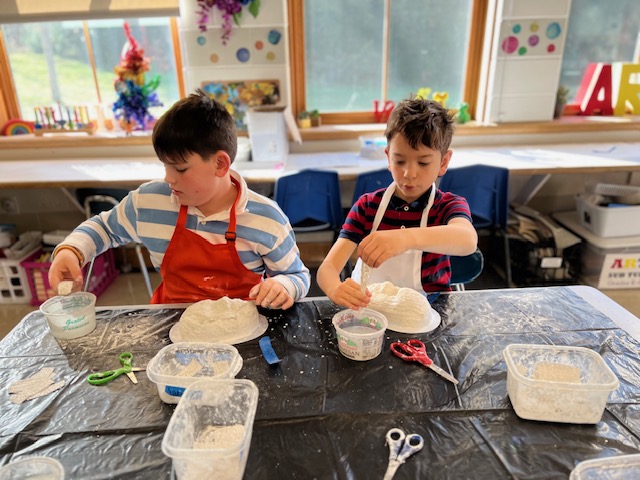
Happy New Year! Here’s to a new year of creativity!
Kindergarten
MICE ON ICE & PENGUIN PALS: Kindergarten students learned about Ed Emberley, author and artist who has created more than 100 children’s books since 1965. After reading this tale students were inspired to create a mixed-media seasonal collage. Using their fingerprints to create their Mice on Ice! Using a variety of hand building techniques Kindergarten students sculpted their own penguin pal.
First Grade
EGYPTIAN CARTOUCHE AND WILLIAM THE HIPPO: Students created a few integrated projects to complement their Egyptian Museum. Each student created a 3D sculpted hippo in honor of the Metropolitan Museum of Art’s mascot that was found in an ancient Egyptian tomb. They also created cartouches using hieroglyphics to form the initials of their names. In Egyptian hieroglyphs, a cartouche is an oval with a line at one end tangent to it, indicating that the text enclosed is a royal name.
Second Grade
TAJ MAHAL: After learning about Ancient India in the classroom students looked at the wonder of the Taj Mahal. Using symmetry and color temperatures to capture its architectural beauty.
SQUIRREL’S EYE VIEW SNOW FIGURES: Second grade students created these “squirrel eye view” perspective snow figures. Inspired by the book, The First Day of Winter by Denise Fleming.
Third Grade
WINTER LANDSCAPES: Third grade students created mixed-media winter landscapes. First creating “stained glass” trees, painting a background and adding the trees using foreground, middle ground, and background.
Fourth Grade
GARGOYLE MASKS: Fourth grade students completed their medieval gargoyles of Notre-Dame. After sculpting with plaster students applied a paint and sand compound to simulate stone.
STARRY NIGHT TREES: Fourth grade students learned about artist Vincent van Gogh. As we examined his famous painting, The Starry Night. Taking inspiration from his swirling night sky, students explored layering textural strokes into the silhouette of trees.
Fifth Grade
ONE-POINT PERSPECTIVE: Fifth grade students designed their own drawings by practicing one and two-point perspective and then using a vanishing-point perspective to create depth. Understanding Renaissance ideals and the era’s respect for classical antiquity, and Renaissance artists’ mastery of vanishing-point perspective.




